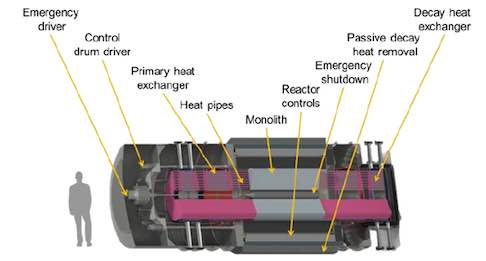
COP26 may have been a near-total failure, but I heard dozens of delegates congratulating each other on being present for what one called “the energy sales conference to end all sales conferences.” And its true that there were more representatives of the fossil fuel industry in Glasgow than any one country-delegation.
It would be ironic if the biggest achievement announced at Cop26 this week is not the international carbon-reduction route-map we were promised, but a groundbreaking business deal between the UK government and Rolls Royce for the supply of miniature nuclear reactors, each capable of powering up to a million households.
Ten years ago I was on the board of a micro-nuclear startup. The company lasted about two years until we were shut down by the American investors, who concluded we had come to market way too early to cash in – the story of my life. At that point I was an energy novice. And I remained convinced that micro-nuclear was the answer to providing safe, reliable power at reasonable cost with very few waste disposal issues.
I kept studying the energy market, expecting micro-grids of all kinds to emerge, especially in developing countries. There has been a gentle rise in micro-energy technology but the thrust has always been big projects. Its time that changed.
Now Warren East of Rolls Royce says he will be able to bring in the first prototypes at a cost to the Exchequer of £35-50 per Megawatt hour – the industry standard unit of cost for energy of all kinds. And, he was quick to point out, this makes them competitive with wind and solar producers which, although they can produce electricity at a lower cost, have yet to solve the problem of how to store their energy for use at times when the sun doesn’t shine and the wind doesn’t blow. Battery technology is advancing rapidly and still has a long way to go.
Paul Dorfman of the Nuclear Consulting Group, an independent think tank, told Radio 4’s Today programme,on Tuesday (9 Nov) that the mini-reactors are actually not that small – about half the size of conventional reactors – and that the Rolls Royce plan to site them within the perimeter of existing nuclear sites does not protect them from the threat faced by the current generation of nuclear reactors – which must be near the sea to guarantee sufficient cooling, where they cannot be adequately protected from flooding.
Warren East had to balance the need to make the reactors as small as possible for safety reasons, against the desire of both UK plc and Rolls Royce to make the project as big as possible. Policymakers and multinationals are addicted to big projects.
World Bank boss David Malpas told an interviewer last week: “The world bank is an institution that does big projects. That means how do you decommission a coal-fired power plant. That actually takes years to do – you have to bring together multiple parties.”
Perhaps what is needed in the battle against climate change is tiny projects that cost a few million each. 10,000 of them, that is a few billion dollars. 100,000 and we begin to change the world.
But more importantly, why are we cementing into place an outdated centralised power grid at just the time when technology is emerging to supercede it?
#Cop26 #nuclearenergy #RollsRoyce #NationalGrid
powkey Portable Power Station 350W, 260Wh/70,000mAh Backup Lithium Battery, 110V Pure Sine Wave Power Bank with 2 AC Outlets, Portable Generator for Outdoors Camping Travel Hunting Emergency
Now retrieving the rating.
$192.98 (as of April 18, 2024 14:24 GMT +01:00 - More infoProduct prices and availability are accurate as of the date/time indicated and are subject to change. Any price and availability information displayed on [relevant Amazon Site(s), as applicable] at the time of purchase will apply to the purchase of this product.)200W Portable Power Station, Powkey 120Wh/33,000mAh Power Bank with AC Outlet, 110V 6 Outputs Solar Generator External Battery Pack with LED Light for Home Use and Outdoor Camping
Now retrieving the rating.
31% OffPortable Power Station 600W, Powkey 296Wh Battery Backup with 2 Pure Sine Wave AC Outlets, USB-C PD100W and 2 Wireless Chargers, Solar Generator (Solar Panel Optional) for Outdoor Camping/RVs/Home Use
Now retrieving the rating.
10% OffFoldable Solar Panel Charger 60W with 18V DC Output (11 Connectors) for 100W~350W Portable Power Stations Jackery/Rockpals/Flashfish/Enginstar, Portable Solar Generator for Outdoor Camping Van RV Trip
Now retrieving the rating.
$98.99 (as of April 18, 2024 14:24 GMT +01:00 - More infoProduct prices and availability are accurate as of the date/time indicated and are subject to change. Any price and availability information displayed on [relevant Amazon Site(s), as applicable] at the time of purchase will apply to the purchase of this product.)10W USB LED Light for Camping Garage Warehouse Car Truck Fishing Boat Outdoor Portable Bulb, Emergency Light, Children Bed Lamp
Now retrieving the rating.
$9.99 (as of April 18, 2024 14:24 GMT +01:00 - More infoProduct prices and availability are accurate as of the date/time indicated and are subject to change. Any price and availability information displayed on [relevant Amazon Site(s), as applicable] at the time of purchase will apply to the purchase of this product.)





